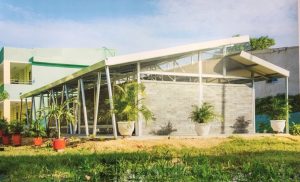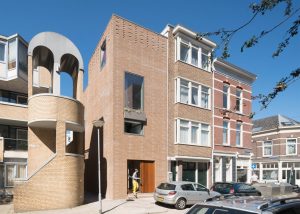These are the startling figures that represent just part of the US construction industry’s waste generation. What’s more, these figures only add up the debris produced through demolition.
While construction, in general, can quickly become wasteful, with concrete in particular known to be extremely resource-intensive, awareness of the issue is growing. In fact, as the sustainability movement continues to become front and center, architects and engineers are looking to more sustainable building materials that can deliver the same properties as conventional materials. Both innovative and environmentally-friendly, here are a few examples of how what was once considered waste can become a cheap and reliable building material with plenty of surprising applications.
The plastic waste house

Source: Conceptos Plasticos
The impact of single-use plastics on the environment is huge, however, moving towards an economy that depends less on petroleum-based plastics is only part of the problem. The plastic that is already in circulation also needs to be addressed.
Conceptos Plasticos is one company addressing the issue, taking plastic waste and turning it into something akin to a LEGO brick. The Columbian company has used around 8 million tons of waste plastic and rubber to date, with each brick slotting neatly together to create cheap, durable, and easily constructed houses. The bricks are manufactured with cavities that can be aligned to allow the installation of electrical cabling within the building—reducing waste through innovative solutions that combine clever planning with simple engineering.
The rubble house

Source: architectuur MAKEN
Demolition accounts for much of the waste associated with construction, so finding alternative ways to use mixed rubble is high on the list of priorities for those in the industry. At the cutting edge of this waste-based movement, Nina Aalbers and Ferry in’t Veld of Architectuur Maken in Rotterdam, Netherlands, are making waves with their uncompromising architecture made from compromised materials—namely, waste ceramics, glass, clay, and brick.
In 2016, the agency’s first house made of reformed bricks was built in Rotterdam, using 15 tons of waste materials compacted into bricks to construct the façade. Special consideration was given to matching the aesthetic with the buildings already standing, and today, it’s barely distinguishable from a house made with standard brick.
The mushroom house

Source: Mushroom Tiny House
Creating building materials out of waste products that are biodegradable may sound counter-intuitive—after all, houses would be useless if they simply rotted away when exposed to the elements. However, mycologists around the world are attempting to do just that, literally growing bricks from waste that can then be left to compost when demolition is required.
In 2014, architect David Benjamin built a 40ft (12m) structure in the courtyard at MoMA PS1, New York, entirely from mushroom bricks. The bricks themselves were made using waste corn husks and mycelium, with a mix of these two materials added to a mold that would grow into the final shape. There’s also other materials being made from mushrooms, with Ecovative’s Mushroom® Insulation keeping this Tiny Home insulated in all temperatures.
The newspaper house

Source: The Paper House
While this house might not exactly be called innovative (it’s already been standing for almost 100 years), it is a prime example of how buildings constructed from waste materials can, in some cases, last longer than conventional materials. Constructed during the Great Depression by Elis Stenman of Rockport, Massachusetts, The Paper House uses compressed paper in place of standard materials such as plasterboard and insulation, with layers of varnish to act as waterproofing.
Stenman’s summer home has withstood the seasons and serves as an archetype to inspire today’s architects and engineers. It’s quite literally a time-tested example of how durable and flexible waste materials can be.
BONUS – Workplaces made with waste
While you might be hard pushed to find entire offices made from waste materials, some of the largest companies in the world are striving to make their workplaces more sustainable. This means that where possible, waste materials have been used in some part of the construction, helping to reduce the reliance on resource intensive materials such as concrete, while boosting company eco-credentials at the same time.
Ecommerce platform Etsy completed its global HQ in Brooklyn, NY, in 2017, using wood that was invasive, salvaged, reused, or sourced from responsibly managed forests. Additionally, much of the furniture inside the office was upcycled or crafted using sustainable materials. Old shipping containers are also used frequently to create studios of real style, while old gas cannisters can double as table legs and plant pots in Taiwan. It seems that when it comes to the workplace, imagination is the only limit to using waste for design within the office.
RTS is already working within the construction and demolition industry to divert waste away from landfill and help architects, engineers, and site managers generate less waste during construction. For more information on how our LEED-accredited team can help your site work more sustainably, contact us.


